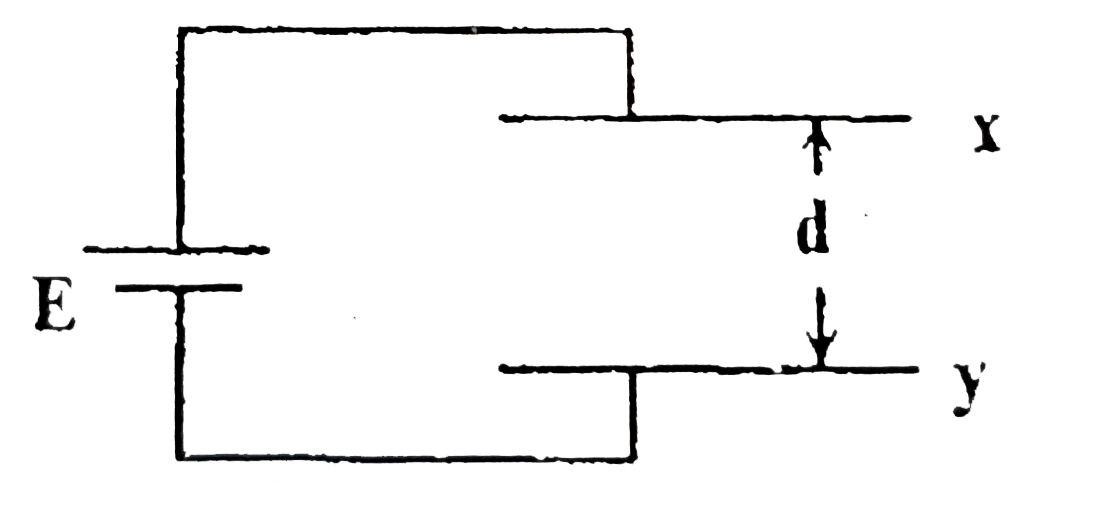In a parallel-plate capacitor, the region between the plates is filled by a dielectric slab. The capacitor is connected to a cell and the slab is taken out. Then
some charge is drawn from the cell
some charge is returned to the cell
the potential difference across the capacitor is reduced
no work is done by an external agent in taking the slab out
The correct Answer is:B
Step by step video, text & image solution for In a parallel-plate capacitor, the region between the plates is filled by a dielectric slab. The capacitor is connected to a cell and the slab is taken out. Then by Physics experts to help you in doubts & scoring excellent marks in Class 12 exams.
Updated on:21/07/2023Topper's Solved these Questions
- ELECTROSTATIC POTENTIAL AND CAPACITANCEBOOK - NARAYNACHAPTER - ELECTROSTATIC POTENTIAL AND CAPACITANCEEXERCISE - C.U.Q (Van De Graff Generator )
2 Videos
- ELECTROSTATIC POTENTIAL AND CAPACITANCEBOOK - NARAYNACHAPTER - ELECTROSTATIC POTENTIAL AND CAPACITANCEEXERCISE - Exercise -1 (C.W)
44 Videos
- ELECTROSTATIC POTENTIAL AND CAPACITANCEBOOK - NARAYNACHAPTER - ELECTROSTATIC POTENTIAL AND CAPACITANCEEXERCISE - C.U.Q (Electrostatics of conductors)
13 Videos
- ELECTROMAGNETIC WAVES BOOK - NARAYNACHAPTER - ELECTROMAGNETIC WAVES EXERCISE - EXERCISE -4
15 Videos
- ELECTROSTATICS AND GAUSS LAWBOOK - NARAYNACHAPTER - ELECTROSTATICS AND GAUSS LAWEXERCISE - Intergers type question
11 Videos
Similar Questions
The capacitance of a parallel plate capacitor is C0 when the region between the plates has air. This region is now filled with a dielectric slab of dielectric constant K. The capacitor is connected to a cell of emf V and slab is taken out. Find (a) charge flown through the cell (b) energy absorbed by the cell and (c) change in energy stored in the capacitor.
View SolutionA parallel plate capacitor is half filled with a dielectric slab of dielectric constant (K) and mass M. Capacitor is connected to a cell of e.m.f. E. Plates are held fixed on horizontal surface. A bullet of mass M hits the dielectric elastically and it is found that the dielectric slab just leaves out the capacitor. Find the speed of the bullet?

View Solution
Knowledge Check
In a parallel plate capacitor, the region between the plates is filled by a dielectric slab. The capacitor is charged from a cell and then disconnected from it. The slab is now taken out :
AThe potential difference across the capacitor increasesBThe charge on the capacitor is increasedCThe energy stored in the capacitor increasesDA work is done by the external agent in taking the slab outSpace between the plates of a parallel plate capacitor is filled with a dielectric slab. The capacitor is charged and then the supply is disconnected to it. If the slab is now taken out then
Awork is not done to take out the slabBenergy stored in the capacitor reducesCpotential difference across the capacitor is decreasedDpotential difference across the capacitor is increasedThe capacitance of a parallel plate capacitor is C when the region between the plate has air. This region is now filled with a dielectric slab of dielectric constant k. The capacitor is connected to a cell of emfE, and the slab is taken out
Acharge CE(k−1) flows through the cellBenegry E2C(k−1) is obserobed by the cellCthe enegry stored in the capacitor is reduced by E2C(k−1)Dthe external agent has to do 12E2C(k−1) amount of work to take the slab out.
The capacitance of a parallel -plate capacitor is C0 when the region between the plates has air. This region is now filled with a dielectric slab of dielectric constant K. The capacitor is connected to a cell of emf ɛ and the slab is takenout
View SolutionA parallel - plate capacitor containing a dielectric slab is connected to a cell. The slab is then taken out of the capacitor slowly. Disregard the forces of gravity and friction. For this process, which of the following statements is incorrect?
View SolutionA parallel-plate capacitor has plate area A, the distance between its two plates x and y is d and a dielectric slab of dielectric constant εr is filled between the regions. It is connected to a cell of emf E. If the dielectric slab is removed, then

View SolutionA parallel plate capacitor has the space between its plates filled by two slabs of thickness d2 each and dielectric constant K1 and K2. d is the plate separation of the capacitor. The capacitance of the capacitor is
View SolutionThe separation between the plates of a parallel plate capacitor is d and the area of each plate is A. iff a dielectric slab of thickness x and dielectric constant K is introduced between the plates, then the capacitance will be
View Solution
